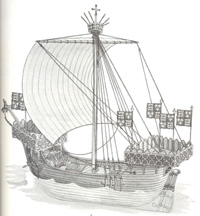Just where and when the first bell made the transition from land to sea remains hidden in the fog of history.
However, we do have documentary evidence from the accounts and inventories of William Soper, Keeper of the King’s Ships, 1422-1427, that at least one English royal vessel, the Rodcogge de la Tour, had a brass bell “to mark the watches of the sailors”. The Rodcogge, originally a prize vessel, was taken into Henry VI’s Royal Squadron in June 1414 and it seems reasonable to assume that a brass bell was part of her inventory at that early date.
Historically, the passing of time on board ship was marked by striking the ship’s bell thus:
- first half hour/one bell
- first hour/two bells
- first hour and a half/three bells
- second hour/four bells
…and so on until the passage of four hours was marked by eight strokes of the bell and the beginning of a new four hour watch.
The four-hour time period between 4:00 pm (1600) and 8:00 pm (2000) is divided into two shorter watches of two hours each. These shorter watches are called the first dog watch – from 1600 to 1800 – and the last dog watch – from 1800 to 2000.

Bells can also play a ceremonial role in services commemorating those lost at sea, as with this ceremony at Ross Bay cemetery in Victoria, B.C.
The United States Navy and the merchant marine have always called the last two-hour period from 1800 to 2000 the second dog watch. The Royal Navy has been somewhat ambivalent. However, in 1932, The Lords Commissioners of the Admiralty made a final decision and settled for the last dog watch.
In today’s Canadian Navy the ship’s bell finds limited use in a ceremonial role at Colours (0800) and, on occasion, it is turned upside down for use as a baptismal font. The name of a baptized child is inscribed on the bell. The Royal Navy, the fountainhead of naval tradition, uses the bell only at Colours. The United States Navy still marks the passage of a watch in the customary fashion.
In the 17th, 18th and 19th centuries the ship’s bell was housed in a belfry, often very ornate, forward at the break of the forecastle. The bell was fixed to a moveable beam which was activated by a lever or a wheel. To this was attached a bell rope that dropped to the main-deck. The arrangement was similar to that found in a church bell tower. That the bell rope was not attached directly to the bell clapper suggests that, in those early days, the ship’s bell was not used to mark the passage of the hours and half-hours as described above. One is not able to control the number of ‘rings’ indirectly through a wheel or lever. One tug on the bell-rope may result in more than one ‘ring’ because the clapper is free to swing within the bell.
Like its land based cousin, the ship’s bell, through the ages, has been used in a number of different ways. On June 20, 1675, Captain William Holden of HMS Assistance and senior officer of a squadron issued Sailing Orders of which Order 8 commanded that “if it prove foggy weather by night or day, we must ring our bells….”.
Currently, the International Regulations for the Prevention of Collisions at Sea, Rule 35, state that vessels 12 metres or more in length whilst at anchor “In or near an area of restricted visibility, whether by day or night………shall at intervals of not more than one minute ring the bell rapidly for about 5 seconds.”
The ship’s bell was also used in gunnery control. The Dutch Navy of the 17th century rang the bell as an order to “open fire”, a practice still evident in the famous night action off Cape Matapan during WWII, the ringing bell in this instance being the modern, electrified gong. Quoting Admiral A.B. Cunningham in HMS Warspite, “It must have been the Fleet Gunnery Officer,………., who gave the final order to open fire. One heard the ‘ting-ting-ting’ of the firing gongs. Then came the great orange flash………”.


 CFB Esquimalt Naval and Military Museum
CFB Esquimalt Naval and Military Museum CFB Esquimalt Naval and Military Museum
CFB Esquimalt Naval and Military Museum CFB Esquimalt Naval and Military Museum
CFB Esquimalt Naval and Military Museum CFB Esquimalt Naval and Military Museum
CFB Esquimalt Naval and Military Museum CFB Esquimalt Naval and Military Museum
CFB Esquimalt Naval and Military Museum CFB Esquimalt Naval and Military Museum
CFB Esquimalt Naval and Military Museum CFB Esquimalt Naval and Military Museum
CFB Esquimalt Naval and Military Museum CFB Esquimalt Naval and Military Museum
CFB Esquimalt Naval and Military Museum CFB Esquimalt Naval and Military Museum
CFB Esquimalt Naval and Military Museum CFB Esquimalt Naval and Military Museum
CFB Esquimalt Naval and Military Museum CFB Esquimalt Naval and Military Museum
CFB Esquimalt Naval and Military Museum CFB Esquimalt Naval and Military Museum
CFB Esquimalt Naval and Military Museum CFB Esquimalt Naval and Military Museum
CFB Esquimalt Naval and Military Museum CFB Esquimalt Naval and Military Museum
CFB Esquimalt Naval and Military Museum CFB Esquimalt Naval and Military Museum
CFB Esquimalt Naval and Military Museum CFB Esquimalt Naval and Military Museum
CFB Esquimalt Naval and Military Museum CFB Esquimalt Naval and Military Museum
CFB Esquimalt Naval and Military Museum